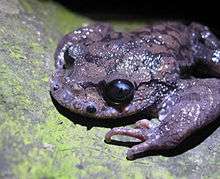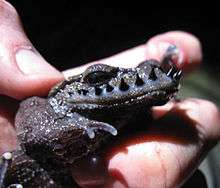Leptobrachium boringii
| Leptobrachium boringii | |
|---|---|
 | |
| Leptobrachium boringii male | |
| Scientific classification | |
| Kingdom: | Animalia |
| Phylum: | Chordata |
| Class: | Amphibia |
| Order: | Anura |
| Family: | Megophryidae |
| Genus: | Leptobrachium |
| Species: | L. boringii |
| Binomial name | |
| Leptobrachium boringii (Liu, 1945) | |
| Synonyms | |
|
Vibrissaphora boringii Liu, 1945 | |
Leptobrachium boringii, commonly known as the Emei moustache toad or Taosze spiny toad, is a species of amphibian in the family Megophryidae. It is endemic to China where it is found in Sichuan, Guizhou, and Hunan provinces. "Emei" or "Taosze" in its common names refer to its type locality, Taosze on Mount Emei, Sichuan.[2] Its natural habitats are temperate forests, grassland, arable land, and rural gardens near rivers. It is threatened by habitat loss.[1]

Reproductive behaviour and strategies
Leptobrachium boringii exhibits sexual selection in a striking way. Male Leptobrachium boringii exhibit conspicuous keratinized nuptial spines that grow on their upper lip during the breeding season—these are the "moustache" and "spines" referred to in its common names. Moreover, male Leptobrachium boringii are larger, on average 75 mm (3.0 in) in snout-vent length, than females, which are on average 67 mm (2.6 in) in SVL (female-biased sexual size dimorphism is more common in frogs[4]). These unusual features seem to relate to male–male combat for best breeding territories and/or female preference for larger males. However, also multiple paternity could be observed, suggesting that some males use the sneaker strategy to fertilize eggs, instead of defending territories.[3]
References
- 1 2 Liang, F.; Guanfu, W. (2004). "Leptobrachium boringii". IUCN Red List of Threatened Species. Version 2013.1. International Union for Conservation of Nature. Retrieved 2013-07-06.
- ↑ Frost, Darrel R. (2013). "Leptobrachium boringii (Liu, 1945)". Amphibian Species of the World 5.6, an Online Reference. American Museum of Natural History. Retrieved 22 September 2013.
- 1 2 Hudson, C. M.; Fu, J. (2013). "Male-biased sexual size dimorphism, resource defense polygyny, and multiple paternity in the Emei moustache toad (Leptobrachium boringii)". PLoS ONE. 8 (6): e67502. doi:10.1371/journal.pone.0067502. PMC 3696078
 . PMID 23840725.
. PMID 23840725. - ↑ Shine, R. (1979). "Sexual selection and sexual dimorphism in the Amphibia". Copeia. 1979 (2): 297–306. doi:10.2307/1443418. JSTOR 1443418.
